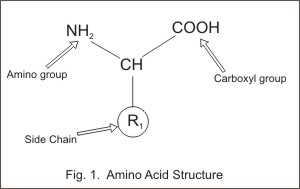A Closer Look at
Protein
Second only to water,
protein is the most abundant substance in the human body. In
addition to forming collagen which is the “glue” that
holds the body together, proteins are involved in every function
in every cell in the body. It is no surprise that protein has
attracted the attention of so many people who are interested in
nutrition. However, there is still much confusion about the right
type and amounts of protein to consume. This confusion is often
aggravated by misinformation that is spread by proponents of fad
diets as well as by companies that sell protein supplements. The
intent of this article is to provide a brief explanation about
the nature of protein, and how it relates to getting the most
utilization of it while minimizing empty calories.
All proteins are composed of amino acids which are bonded
together in long chains called polypeptides. The sequences of the
amino acids, along with the folds in the protein structure,
determine the type and function of the protein. There are 20
amino acids that combine to form proteins, of which 9 cannot be
manufactured in the human body and are therefore essential in the
diet. This means that these 9 amino acids are really the
essential nutrients, and that protein is nothing more than the
packaging for them. Consequently, any protein source
that is deficient in any of the essential amino acids is incomplete.
Also, under some stressful conditions, some of the
“non-essential” amino acids become essential in the
diet because the body’s ability to make them becomes
limited.
Essential Amino Acids
Non-Essential Amino Acids
Histidine
Alanine
Isoleucine
Arginine (Can be essential in infants)
Leucine
Asparagine
Lysine
Aspartic Acid
Methionine
Cysteine (Conditionally Essential)
Phenylalanine
Glutamic Acid
Threonine
Glutamine
Tryptophan
Glycine
Valine
Proline
Serine
Tyrosine (Conditionally Essential)

For someone who is trying to lose fat or build muscle while
staying lean, it is important to maximize the percentage of
protein that is being used for tissue repair, muscle
building/maintenance, and other vital functions while minimizing
the percentage that gets converted to empty calories. This means
consuming high quality protein. It is also important to not
inundate the body with excessive amounts of protein. Contrary to
what is printed in muscle magazines and other literature
controlled by entities that sell protein, experiments show that
about .82 grams per lb of lean mass is adequate for people who
are trying to gain muscle. It is equally important to make sure
that protein is not absorbed more rapidly than the body can
properly utilize it. Consequently, although rapidly absorbed
proteins such as whey protein are good right after a workout,
more slowly absorbed protein sources are better throughout the
rest of the day.